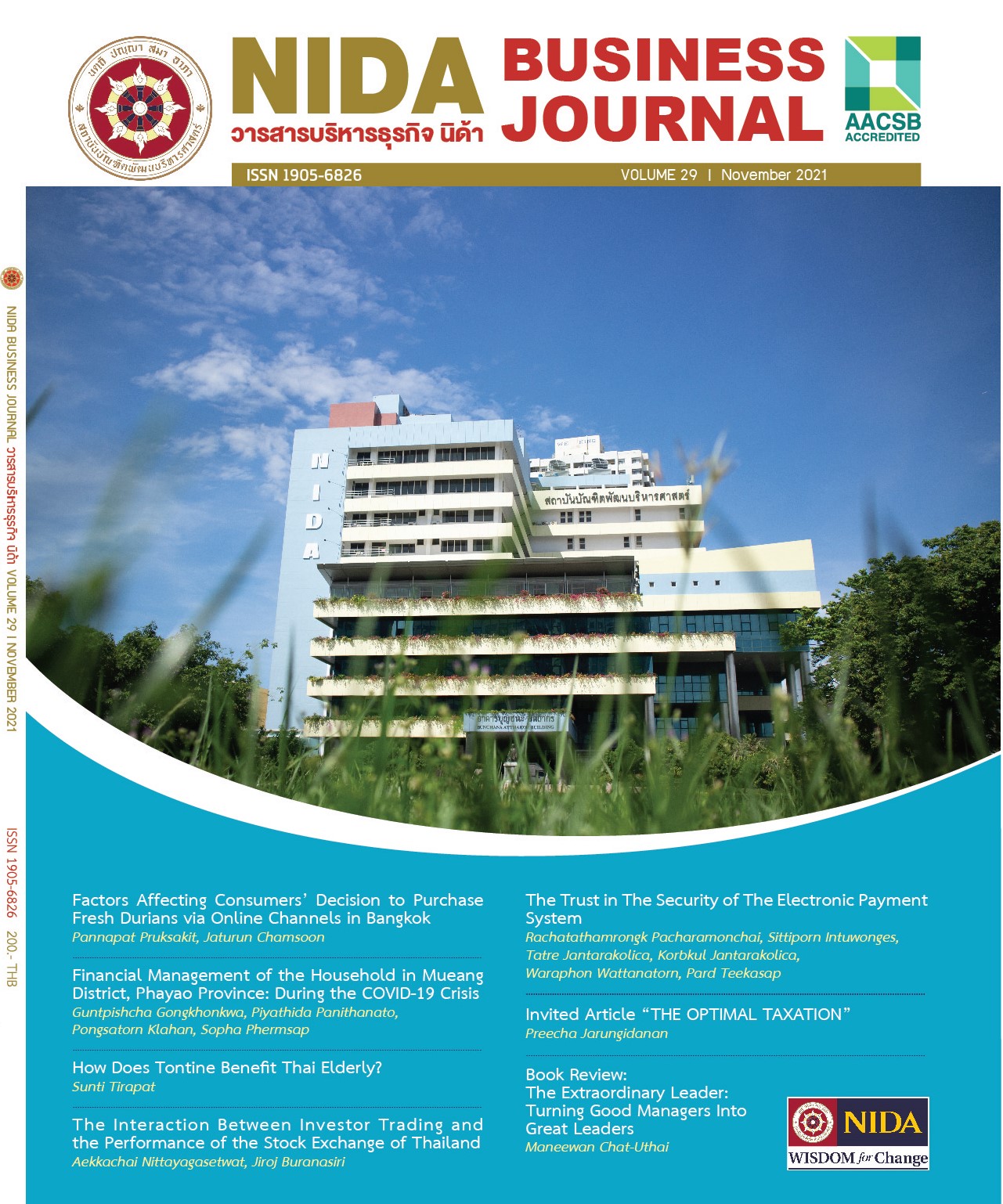Tontine เหมาะสมกับผู้สูงอายุไทยหรือไม
คำสำคัญ:
ผู้สูงอาย, ทอนทีน, การออมบทคัดย่อ
Tontine ซึ่งเป็นตราสารการเงินที่กลับมาได้รับความสนใจอีกครั้งหนึ่งในการแก้ปัญหาของผู้สูงอายุ การศึกษา เปรียบเทียบลักษณะผลตอบแทนของตราสารนี้กับผลิตภัณฑ์ที่มีอยู่ในปัจจุบัน คือ Annuity และสลากออมสิน การวิเคราะห์ ใช้การทดลองสุ่ม (Simulation) จากตัวอย่างผู้สูงอายุ 60 ปี พบว่าค่าเฉลี่ยมูลค่าปัจจุบันที่ได้รับจาก Tontine เพิ่มขึ้นเมื่อ จำนวนผู้ร่วมลงทุนมากขึ้นในช่วงต้น และจะเริ่มคงที่เมื่อมีจำนวนผู้ร่วมลงทุนมากกว่า 100 คนขึ้นไป ลักษณะของผลตอบแทน ไม่เป็นการกระจายตัวแบบปกติ (Normal Distribution) มีลักษณะเบ้ขวาและ “หางอ้วน” เมื่อเปรียบเทียบผลตอบแทน ของ Tontine กับ Annuity พบว่า Tontine แบบธรรมชาติ (Natural Tontine) และ Annuity มีลักษณะผลตอบแทนที่ ใกล้เคียงกัน ต่างจากผลตอบแทนของ Tontine แบบคงที่ (Flat Tontine) ที่มีค่าเฉลี่ยมูลค่าปัจจุบันของผลตอบแทนต่ำกว่า แต่มีความเบ้ขวาสูง ซึ่งเป็นลักษณะที่ผู้ชอบความเสี่ยงต้องการ นอกจากนั้น การเปรียบเทียบ Flat Tontine กับสลากออมสิน ที่มีการจูงใจโดยมีโอกาสถูกรางวัล พบว่า Flat Tontine ที่อัตราผลตอบแทน 3% ต่อปี ให้มูลค่าเฉลี่ยปัจจุบันใกล้เคียงกับ การลงทุนในสลากออมสิน แต่ผลตอบแทนของ Tontine มีความผันผวนและความเบ้ขวาสูงกว่ามาก การลงทุนในสลาก ออมสินจึงเหมาะกับผู้สูงอายุที่ไม่ชอบความเสี่ยงและให้ความสำคัญกับการให้มรดกแก่ลูกหลาน นอกจากนั้น ยังมีสภาพคล่อง เพราะผู้สูงอายุสามารถนำเงินต้นมาใช้ได้หากจำเป็น ในขณะที่ Tontine ไม่สามารถยกเลิกการลงทุนเพื่อเอาเงินต้นคืนได้ โดยสรุปผลิตภัณฑ์ Tontine มีความเหมาะสมกับผู้สูงอายุประเภทที่ชอบความเสี่ยงมากกว่าผลิตภัณฑ์การออมที่มีอยู่ใน ปัจจุบัน ดังนั้นในการรับมือสังคมผู้สูงอายุ รัฐบาลควรส่งเสริมการใช้กลไกทางตลาดการเงินเพื่อลดภาระทางการคลังของ ภาครัฐ และสนับสนุนให้มีทางเลือกในการออมรูปแบบต่างๆ ที่ตอบสนองความต้องการของผู้สูงอายุที่แตกต่างกันได้ การศึกษานี้จำกัดการวิเคราะห์ Tontine ที่มีรูปแบบมาตรฐาน แต่ผลิตภัณฑ์นี้สามารถออกแบบให้เหมาะสมกับบริบทของ ผู้สูงอายุไทยได้ ซึ่งควรมีการศึกษาต่อไป
References
Benartzi, S., A. Previtero, and R. H. Thaler. 2011. “Annuitization Puzzles.” Journal of Economic Perspective, 25 (4): 143-164.
Blake, D. 1999. “Annuity Markets: Problems and Solutions.” The Geneva Papers on Risk and Insurance -Issues and Practice, 24: 358-375.
Beshears, J., J. J. Choi, D. Laibson, B. C. Madrian, and S. P. Zeldes. 2014. “What makes annuitization more appealing?” Journal of Public Economics, 116: 2-16.
Brown, J. 2009. Understanding the Role of Annuities in Retirement Planning. In Annamaria Lusardi, ed., Overcoming the Savings Slump: How to Increase the Effectiveness of Financial Education and Saving Programs. University of Chicago Press: 178-206.
Cole, S.A., B. Iverson, and P. Tufano. 2021. “Can Gambling Increase Savings? Empirical Evidence on PrizeLinked Savings Accounts.” Management Science (forthcoming).
Cohen, Jacob. 1953. “The Element of Lottery in British Government Bonds, 1694-1919.” Economica, 20: 237-246.
Dizon, Felipe and T. Lybbert. 2021. “Leveraging the Lottery for Financial Inclusion: Lotto-Linked Savings Accounts in Haiti.” Economic Development and Cultural Change, 69 (4): 1323-1349.
Filiz-Ozbay, E., J. Guryan, K. Hyndman, M.S Kearney, and E.Y. Ozbay. 2015. “Do Lottery Payments Induce Savings Behavior? Evidence from the Lab.” Journal of Public Economics, 126 (June): 1-24.
Fullmer, R. K. and J. B. Forman. 2020. “State-sponsored Pensions for Private Sector Workers: The Case for Pooled Annuities and Tontines.” Wharton Pension Research Council Working Paper.
Fullmer, R. K. 2019. “Tontines: A Practitioner’s Guide to Mortality-Pooled Investments.” CFA Institute Research Foundation Briefs.
Gertler, P., S. Higgins, A. Scott, and E. Seira. 2021. “Increasing Financial Inclusion and Attracting Deposits through Prize-Linked Savings.” Working Paper. UC Berkeley.
Hu, W.Y. and J. S. Scott. 2007. “Behavioral Obstacles in the Annuity Market.” Financial Analysts Journal, 63: 71-82.
Iwry, J. M., C. Haldeman, W. G. Gale, and D. John. 2020. “Retirement Tontines: Using a Classical Finance Mechanism as an Alternative Source of Retirement Income.” Brookings Institute Report.
Lange, Andreas & List, John A. & Price, Michael K., 2007. “A fundraising mechanism inspired by historical tontines: Theory and experimental evidence.” Journal of Public Economics, Elsevier, Vol. 91 (9): 1750-1782.
McKeever, Kent. 2009. “A short History of Tontines.” Fordham Journal of Corporate & Financial Law, 15 (2): 49-509.
Milevsky, M.A. 2014. “Portfolio choice and longevity risk in the late seventeenth century: A re-examination of the first English tontine.” Financial History Review, 21 (3): 225-258.
Milevsky, M. A. 2015. “King William’s Tontine: Why the Retirement Annuity of the Future Should Resemble Its Past.” Cambridge, UK: Cambridge University Press.
Milevsky, M.A. and T.S. Salisbury. 2015. “Optimal Retirement Income Tontines.” Insurance: Mathematics and Economics, 64: 91-105.
Modigliani, F. 1986. “Life cycle, individual thrift, and the wealth of nations.” Science, 234: 704-712.
Newfield, P. 2014. “The Tontine: An Improvement on the Conventional Annuity?” Journal of Retirement 1 (3): 37-48.
Ransom, R., and R. Sutch. 1987. “Tontine Insurance and the Armstrong Investigation: A Case of Stifled Innovation, 1868-1905.” The Journal of Economic History, 47 (2): 379-390.
Tufano P. 2008. “Saving Whilst Gambling: An Empirical Analysis of UK Premium Bonds.” American Economic Review, 98 (2): 321-326.
Tufano P., N. Maynard, J.E. De Neve. 2008. “Consumer demand for prize-linked savings: A preliminary analysis.” Harvard Business School Working Paper No. 08-061, Harvard Business School, Cambridge, MA.
Downloads
เผยแพร่แล้ว
How to Cite
ฉบับ
บท
License

This work is licensed under a Creative Commons Attribution-NonCommercial-NoDerivatives 4.0 International License.



